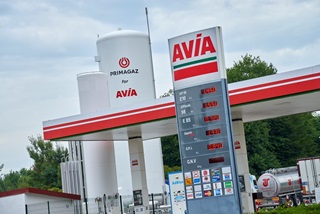
LNG is cheaper than diesel and has strong environmental benefits.
For decades, diesel has been the default option for vehicle fleets. But all that is changing. Now there are other, better choices on the market that give the same performance in terms of power, acceleration, and cruising speed, but with added financial and environmental benefits.
LNG is typically 10-25% cheaper than diesel7 giving lower running costs over medium to long distances and the lowest total cost of ownership compared to conventional fuels. It also has strong environmental benefits that improve air quality in cities. LNG-powered trucks have comparable performance to diesel vehicles in terms of power, acceleration and cruising speed, but can cut CO2 by between 10% and 20%8, dependent upon duty cycle and vehicle type. LNG is not just for land-based vehicles but, with the growth of emission control areas (ECAs), LNG is also becoming an increasingly popular marine fuel9. It is a proven energy source, which is affordable, performs well and offers 24% more energy output per tonne than heavy fuel oil. It is also reassuring to know that the technology used for LNG vehicles is mature and safe. And with governments increasingly turning to domestic inland waterways to boost transport efficiency, LNG is considered one of the most promising alternative fuels in the transition to clean transport in shipping10.
LNG is an increasingly popular choice for low-emission, economic transport worldwide. It is widely used for personal and public transport and heavy-duty trucks, as well as marine and rail transport. Backed by local and central government transport policy, LNG is the fastest-growing fossil fuel worldwide, predicted to account for 20% of HGVs sold by the early-2020s12.

Partnership Primagaz France - Avia
Read how leading independent fuel retailer Avia is keeping drivers on the road with its network of LNG refuelling stations throughout France.
LNG-only refuelling stations or ‘mixed stations’ offering LNG and Liquid to Compressed Natural Gas (LCNG) are used to fuel transport. Designed and manufactured to ISO 16924 and ISO 16923 standards, they conform to both European and local requirements. Find out more about LNG.
Technical control room
Optimal monitoring through made-to-measure sized container.
LIN tank + LIN System
LNG venting prevention in case of low or irregular consumption
LNG storage tank
Available in compact, mid or large format
LNG dispenser
Potential for dual side refuelling
LNG pump skid + Saturation on the fly system
Allows to fill all types of trucks
Offloading line
Position tailored relative to offloading area
7 Source: Vos Logistics whitepaper
8 Source: Vos Logistics whitepaper
10 Source: Gastech Insights 21/2/19 https://gastechinsights.com/article/introducing-lng-for-inland-shipping-designing-the-sea-river-lng-carriers
11 Source: Kinetrex Energy https://www.kinetrexenergy.com/7-myths-lng-diesel-fleets/
12 Source: Martin Flach, Iveco Product Director
